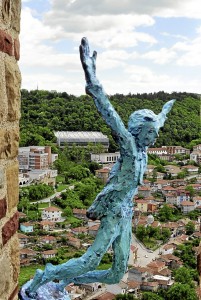In his childhood, Pototsky had a hard life. He was born in the Gulag, a forced-labor and concentration camp, and battled with osteomyelitis for nine years. Despite the travails, he remained unscathed. Instinctively, he felt he had to use art to remind people that the spirit was the canvas colored by the virtues they directed toward others.
In his travels, Pototsky wears two hats as artist and president of the International Academy of Kindness, a nonprofit organization that espouses that the ultimate creativity is kindness. It is a virtue that empowers man to give the most profound happiness from the heart, knowing that such resplendence will create a rippling effect.
“Where there is kindness, there are no borders,” says Pototsky.
He demonstrates his own benevolence by donating his “Symbol of Kindness” sculpture to Cebu, which will be inaugurated today in front of the provincial capitol. Later this week, he will donate his bronze plaque of Elpidio Quirino to the former Philippine President’s ancestral house in Vigan.
In 1949, Quirino allowed 6,000 Russians who escaped the revolution to stay in the country. The memorial plaque is Russia’s expression of gratitude to the Philippines.
This year, Pototsky created a statue of José Rizal for Las Piñas, upon the invitation of Sen. Manuel Villar. He also created the monument of Alexander Pushkin in Intramuros and Leo Tolstoy at the Cebu Convention Center.
He is famous for his collection of bronze portraits of such prominent individuals as designer Pierre Cardin, actors Maximillian Schell, Gerard Depardieu and Alec Baldwin, and author Alexander Solzhenitsyn.
Monuments worldwide
When he works on these portraits, he picks up the subject’s vibes and reads their personality. “It is a gift from God. I can read a face like a book.”
These artworks are his way of acknowledging the greatness of their spirits and making them known to the world.
Pototsky has donated over 65 monuments worldwide. The monument to St. Nicholas Thaumaturge was inaugurated in Washington to commemorate international ties and tolerance between Russia and America. Anton Chekhov’s bust in Sri Lanka paid homage to the author’s stay on the island. Pushkin’s bust in Turkey honored his descendants from the Middle East. The “America is Victor of Peace” monument in Miami was a tribute to America’s role in foreign affairs.
Pototsky’s first encounter with art was in his childhood. While growing up in the Gulag, he saw how people were transferred to Siberia for no apparent reason. He saw the poverty and inhumanity.
“People lived like animals in houses below the ground. My mother was a seamstress. She made beautiful clothes. It was my first exposure to art.”
From ages 3 to 12, he struggled with his bone disease until he recovered. “I realized I wanted to help people in situations worse than mine. The best way was through art. When people begin to understand art, it will be life-changing.”
Pototsky studied at the State Institute of Arts in Odessa and Kishinev State University. He first worked in a ceramic factory.
Since 1979, he has been joining exhibitions in the former Soviet Union and around the world. His atelier and gallery are located in the cultural heart of Moscow.
He has used his art to help people and foster international ties. When he met Stephen Baldwin in Moscow, the actor requested Pototsky to meet his older brother Alec, who was mired in personal problems. When Pototsky met the older the Oscar nominee, he advised him: “Only when we are kind can we be human.”
“It means that we are one earth for as long as we are kind. I asked people to recollect their experiences of kindness and put this seed into society.”
Then there’s the strained ties between Russia and Estonia born out of historical, territorial, cultural issues and human-rights concerns. The result was the closure of the embassies in both countries.
“I told the Estonians to be kind to themselves. In fact, all problems will be solved through kindness. Dostyevsky once said beauty would save the world if people would be kind.”
People wonder why Pototsky donates his monuments. “There is no art if it is purely for commerce. Why should artists be concerned about money? We have our spiritual treasures from the day we were born.”